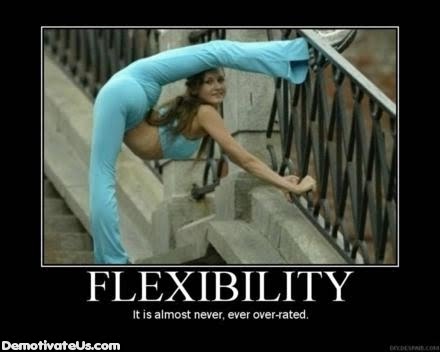Posted May 5, 2010
Muscle Tightness: Overactive Fatigue vs. Dysfunctional Stiffness
I was teaching a movement screening class today, and when I asked the class what it meant if I couldn’t get deep into an overhead squat, one of the students correctly said that it was because of my tight hamstrings, and that I should focus on stretching them. I then proceeded to ask her a very simple question: “Why are my hamstrings tight?”
There are only two ways a muscle can get tight. One is if the muscle is overactive and holding tension because of an imbalance somewhere in the body – in this case it was because of a bulging disc in my L4-S1 region, which made my low back less than stable and therefore the hamstrings had to “pick up the slack” for my low back. The other scenario is when the muscle is dis-used and less than optimally functional, and begins to atrophy and stiffen. Each scenario means the muscle becomes shorter and less than optimally functional, but only one will actually benefit from stretching. If a muscle is holding tension because it is making up for another area, stretching it will only cause more problems, sort of like stretching the wires of a bicycle tire.

As the wheel loses that stability, it becomes “out of true” and winds up warping and not working too well. So if my hamstrings were tight to make up for my low back, stretching them without stabilizing my back would actually make the problem worse. Normally, when something happens to make my back start to hurt, the first thing that happens is that my glutes and hamstrings tighten up almost immediately. The first thing I do is start to do some light core activation work and spinal stabilization work, and magically my hamstrings feel better!!
If the muscles are stiff from dis-use, the best thing is not simply static stretching to gain length, but a series of active stretches to engage that muscle and the ones around it. This helps to reset the neuromechanical transmitters to lower the tone of the muscle and allow it to re-gain its’ strength and ability to contract and relax properly. This is the type of tight muscle that should be stretched.
Trainers have a bit of a knee-jerk reaction to tight muscles in that they want to stretch the heck out of them for the simple fact that they are tight. In many cases those tight muscles are tight for a reason, and that reason needs to be looked at, otherwise the training program might cause the person to get into more pain that helping them get through pain. Additionally, you can never look cool stretching, except in some cases.


So looking into why that muscle is tight would help save a lot of time, effort and problems down the road, and may help make training programs better suited to the clients goals, not just the simple “stretch the tight, strengthen the weak” approach to imbalances. It’s always fun working on someones’ upper back and having them realize that they can now touch their toes for the first time in years, or having someone roll out their foot, and feeling less back pain in a minute. The body will always tell us what is wrong, we have to be able to listen close enough and have the chance to step outside of what we know. That trainer today was right that my hamstrings were tight, and hopefully after today she will be willing to see why they were tight.
[gravityform id="3" name="Blog Post Capture. " title="false"]



6 Responses to Muscle Tightness: Overactive Fatigue vs. Dysfunctional Stiffness